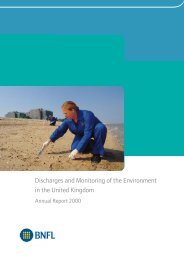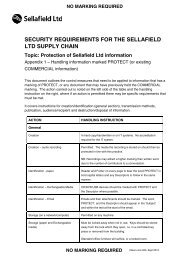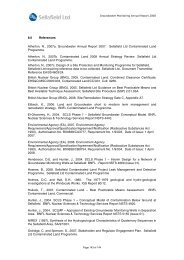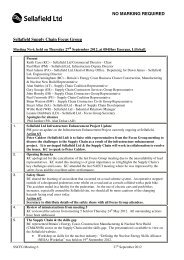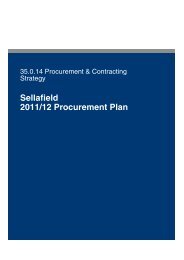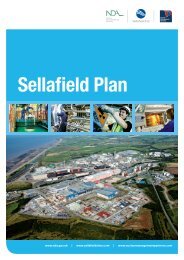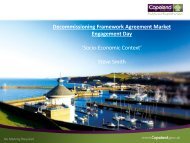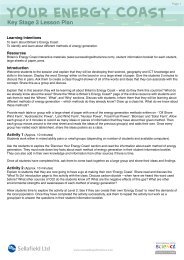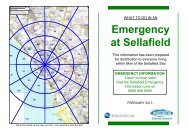Annual Report for 2010/11 and Forward Programme - Sellafield Ltd
Annual Report for 2010/11 and Forward Programme - Sellafield Ltd
Annual Report for 2010/11 and Forward Programme - Sellafield Ltd
You also want an ePaper? Increase the reach of your titles
YUMPU automatically turns print PDFs into web optimized ePapers that Google loves.
SSEM/20<strong>11</strong>/4730 June 20<strong>11</strong>Fundamentally, the priority question is “What risk do the particles pose?” with all otherquestions becoming academic if the risks are demonstrably low enough to be regarded asacceptable. The HPA risk assessment provides strong demonstration that the risks to beachusers are very low (one in a hundred thous<strong>and</strong> million of a fatal cancer), but that some beachmonitoring should continue in order to provide reassurance that risks remain very low.Based on the available in<strong>for</strong>mation, the risk from offshore particles is also considered to below <strong>and</strong> regarded as acceptable by the FSA.The programme of work <strong>for</strong> particles in the environment could there<strong>for</strong>e now be regarded asa programme of reassurance, the scope of which is driven by the ability to demonstrate thatrisks continue to be acceptable. In order to achieve this <strong>and</strong> address the questions set-outabove, the programme <strong>for</strong> 20<strong>11</strong>/12 has the following main objectives:Beach Monitoring- to complete a programme of large area beach monitoring using the Nuvia Synergy systemthat achieves:- monthly monitoring (at least 10 times per year) at <strong>Sellafield</strong> beach;- monitoring of the full extent of the str<strong>and</strong>-line between St Bees <strong>and</strong>Ravenglass:- monitoring at local beaches with the highest public occupancy <strong>for</strong> riskreassurance;- repeat area monitoring to underst<strong>and</strong> repopulation at the following beaches:i. <strong>Sellafield</strong>ii. Braystonesiii. Seascaleiv. St Bees- recovery of all particles detected;<strong>and</strong>:- avoids as far as possible, monitoring during the peak tourist seasons.Find Analysis- to deposit all finds in the SL laboratory <strong>for</strong> gamma scan;- to complete the Tranche 3 detailed analysis by October 20<strong>11</strong> (Serco/NPL)Data Analysis <strong>and</strong> interpretation- to continue populating the GIS system with data on the position <strong>and</strong> type of all finds;- to investigate <strong>and</strong> review the sources <strong>and</strong> pathways of beta-rich finds;- to interrogate beach monitoring data to determine find arrival / repopulation rates; <strong>and</strong>- to investigate application of statistical techniques <strong>and</strong> engage statistics experts to furtherevaluate beach monitoring data.Offshore Monitoring- to investigate options <strong>for</strong> the trial of the Dounreay ROV;- to support EA in achieving sampling of offshore sediments;- to develop the scope <strong>and</strong> specification <strong>for</strong> award of an offshore monitoring contract (seeexample Task Sheet, Figure 7.3)Risk Assessment- to provide data to HPA <strong>for</strong> their review of the risk assessment, to account <strong>for</strong> developmentsfollowing the introduction of Groundhog Synergy; <strong>and</strong>- to review the findings of the risk assessment to in<strong>for</strong>m the particles in the environmentprogramme of work© Nuclear Decommissioning Authority 20<strong>11</strong>. 94



